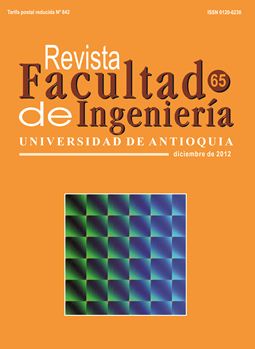Estudio de dos estructuras neuronales feedforward para la compresión de imágenes digitales
DOI:
https://doi.org/10.17533/udea.redin.14178Palabras clave:
compresión digital de imagenes, redes neuronales feedforward, relazión pico señal a ruido, tasa de compresión, comprensión con perdidasResumen
Este documento muestra y explica el proceso para comprimir imágenes, en escala de grises y a color, usando dos topologías neuronales: función de imagen y embudo. Para el análisis de los esquemas neuronales se consideran el número de neuronas y capas, tipo de imagen, tamaño y cantidad de bloques durante el entrenamiento; con el fin de dar soporte experimental a las arquitecturas neuronales. También se analizan criterios de calidad de la imagen obtenida, como relación pico señal a ruido (PSNR) y tasa de compresión. Se evidencia la importancia de la selección de parámetros evaluados en calidad y tiempo de compresión. El proceso de experimentación muestra que la arquitectura tipo embudo permite lograr valores superiores a 35dBen términos de PSNR y 2 bits por pixel en imágenes en grises o 3 bpp en imágenes a color, con tiempos inferiores a 3 segundos para imágenes menores a 1 mega pixel. Finalmente, se realizan algunas recomendaciones basadas en la metodología empleada cuando se desee realizar comprensión de imágenes con redes feed-forard entorno a la selección de parámetros de la arquitectura, al pre-procesamiento de la imagen y al entrenamiento de la red.
Descargas
Citas
Tecnología de los contenidos multimedia. Edición y compresión de imágenes estáticas. Programa oficial de postgrado: Master en comunicaciones, redes y gestión de contenidos. España. Disponible en: http://ocw.innova.uned.es/mm2/tcm/contenidos/pdf/tema3.pdf. Diciembre 2008.
R. Ferzli, M. Adnan. Subsampling image compression using Al-Aloui backpropagation algorithm. Electronics, Circuits and Systems. 14th IEEE International Conference. Arizona. 2007. pp. 1260-1263. DOI: https://doi.org/10.1109/ICECS.2007.4511226
W. Gillespie. Still image compression using neural networks. Utah University. Logan. UT. 2005.
V. Rama, P. Vaddella, K. Rama. “Artificial neural networks for compression of digital imágenes: a review”. International Journal of Reviews in Computing. Vol 10. 2010. pp. 75-82
D. Alvarez, M. Guevara, G. Holguin. Preprocesamiento de imágnes aplicadas a mamografías digitales. Universidad tecnológica de Pereira. Scientia et Technica Año XII. No 31. Pereira. Colombia. 2006. pp. 1-6.
A. Durai, E. Saro. “Image Compression with Back- Propagation Neural Network Using Cumulative Distribution Function”. World Academy of Science, Engineering and Tech. Vol. 17. 2006. pp. 60-64. DOI: https://doi.org/10.1109/ADCOM.2006.4289904
S. Basu, K. Kayal, J. Sil. Edge preserving image compression technique using adptative feed forward neural network. Proceedings of the ninth IASTED International Conference INTERNET AND MULTIMEDIA SYSTEMS AND APPLICATION. Switzerland. 2005. pp. 467-471.
H. Sahoolizadeh, A. Suratgar. Adaptative image compression using neural networks. Setit, 5th International Conference: Sciences of Electronics Technologies of Information and Telecommunications. Tunisia. 2009. pp. 1-5.
I. Vilovic. An experience in image compression using neural networks. 48th International Symposium ELMAR Focused on Multimedia Signal Processing, Zadar Croatia. 2006. pp. 95-98. DOI: https://doi.org/10.1109/ELMAR.2006.329523
Signal and image processing institute. Ming Hsieh Department of Electrical Engineering. University of southern. California. Disponible en: http://sipi.usc.edu/database/database.php?volume=misc&image=12 Consultado en Noviembre de 2011.
N. Lugo, F. Roldan. “Imágenes usadas en la compresión de imágenes con redes neuronales”. Disponible en: https://rapidshare.com/files/3208725692/Imágenes_usadas_en_la_compresión_de_imágenes_con_redes_neuronales.rar. Publicado en Enero de 2012 y consultado Marzo de 2012.
Descargas
Publicado
Cómo citar
Número
Sección
Licencia
Derechos de autor 2018 Revista Facultad de Ingeniería

Esta obra está bajo una licencia internacional Creative Commons Atribución-NoComercial-CompartirIgual 4.0.
Los artículos disponibles en la Revista Facultad de Ingeniería, Universidad de Antioquia están bajo la licencia Creative Commons Attribution BY-NC-SA 4.0.
Eres libre de:
Compartir — copiar y redistribuir el material en cualquier medio o formato
Adaptar : remezclar, transformar y construir sobre el material.
Bajo los siguientes términos:
Reconocimiento : debe otorgar el crédito correspondiente , proporcionar un enlace a la licencia e indicar si se realizaron cambios . Puede hacerlo de cualquier manera razonable, pero no de ninguna manera que sugiera que el licenciante lo respalda a usted o su uso.
No comercial : no puede utilizar el material con fines comerciales .
Compartir igual : si remezcla, transforma o construye a partir del material, debe distribuir sus contribuciones bajo la misma licencia que el original.
El material publicado por la revista puede ser distribuido, copiado y exhibido por terceros si se dan los respectivos créditos a la revista, sin ningún costo. No se puede obtener ningún beneficio comercial y las obras derivadas tienen que estar bajo los mismos términos de licencia que el trabajo original.










 Twitter
Twitter